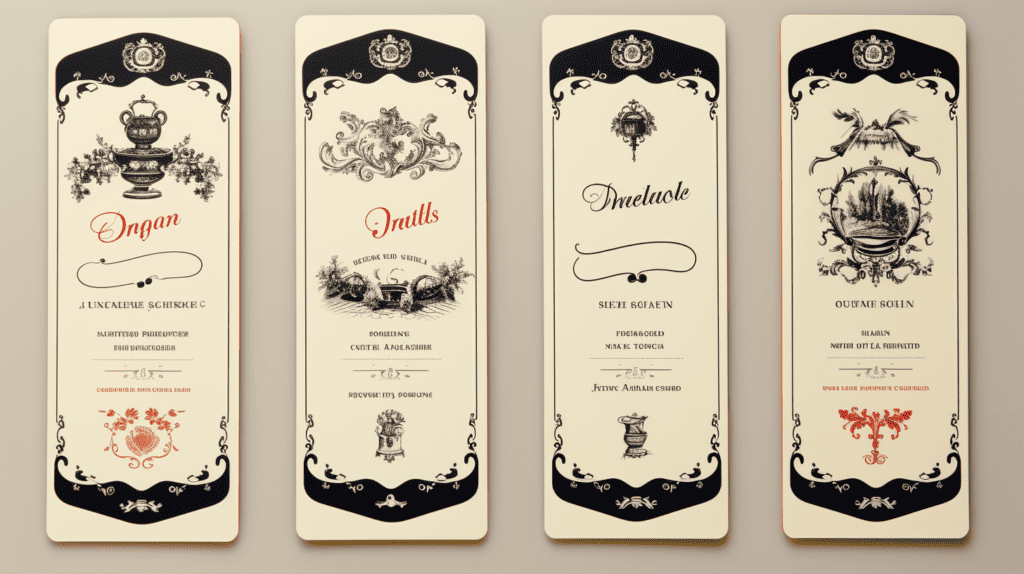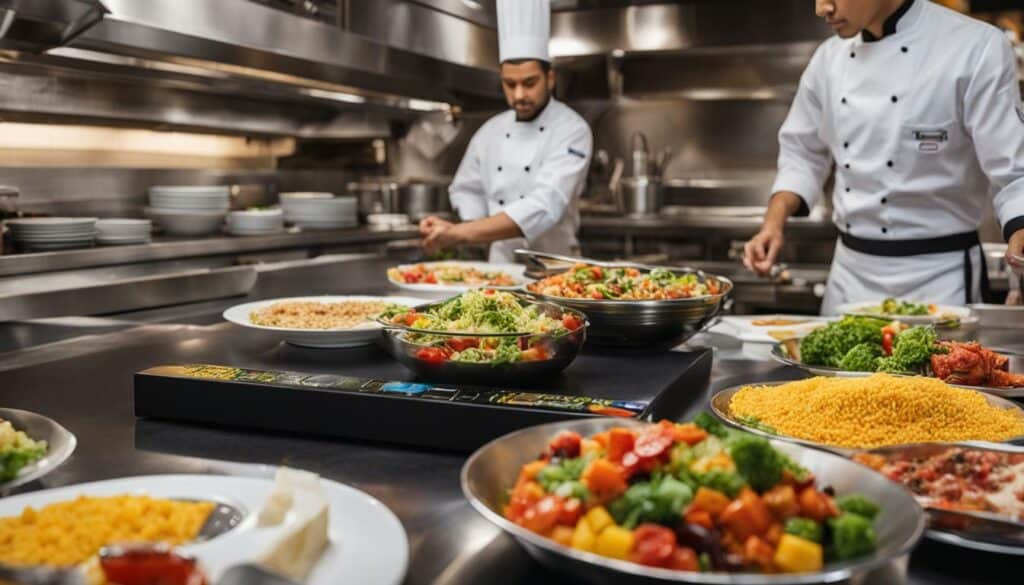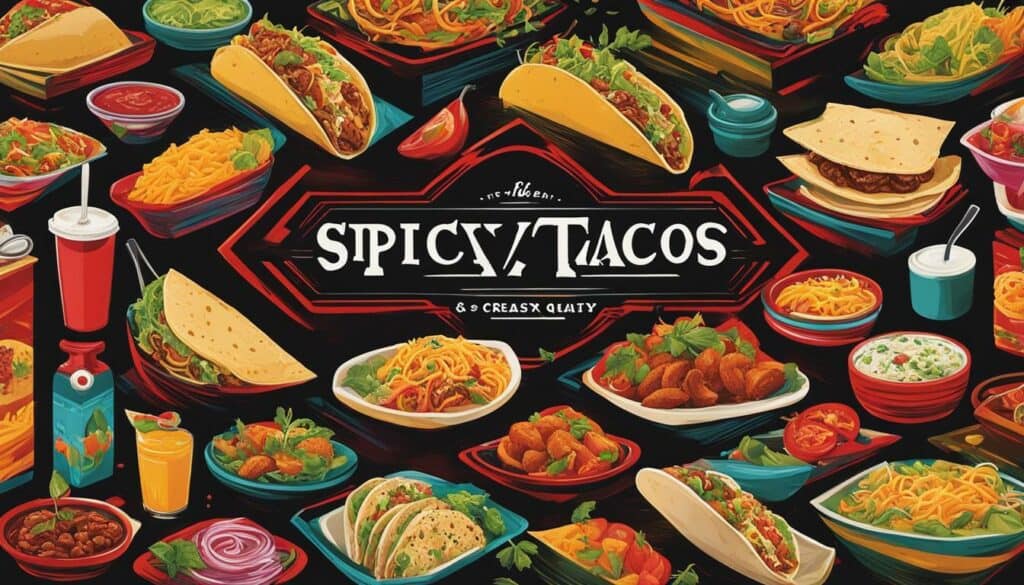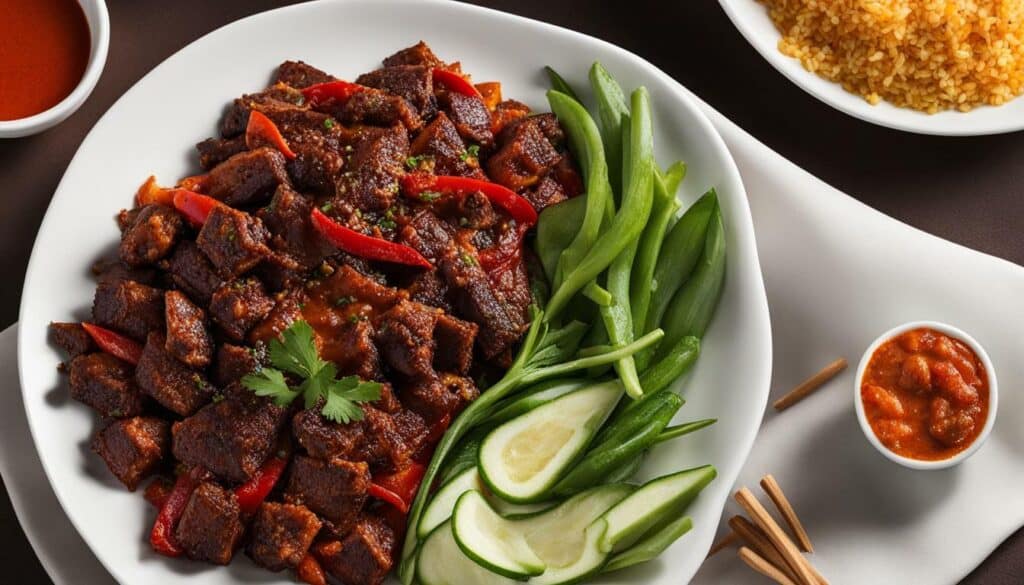Are you looking to add an exciting twist to your meals? Discover how a new menu label can spice up your dining experience! A fresh menu label has the power to transform your meals by enticing your taste buds and creating a visually appealing presentation. With the right design and attention to detail, you can elevate your menu to new heights.
- Think logically about the organization and layout of your menu
- Keep your menu simple and easy to read for customers
- Maintain consistency with your brand identity
- Get creative with unique menu designs to stand out
- Write compelling menu descriptions that trigger the senses
By following these menu design tips and incorporating enticing descriptions, you can enhance the overall dining experience for your customers. Additionally, consider incorporating global street food, such as hand-held variety and grilled skewered meats, to add a unique and trendy touch to your menu. So why wait? Spice up your meals with a new menu label and let your culinary creations take center stage!
Designing an Eye-Catching Menu Label
Designing a captivating menu label is crucial for catching the attention of your customers. Let’s explore the key aspects of creating an eye-catching design that reflects your brand.
1. Think logically about the organization of your menu
When designing your menu label, it’s important to structure it in a logical and easy-to-read format. Start with an attention-grabbing headline or logo at the top, followed by clear sections for appetizers, main courses, desserts, and drinks. Consider using colors and fonts that match your restaurant’s branding to maintain consistency and make it visually appealing.
2. Keep it simple and easy to read
A cluttered and complicated menu label can overwhelm your customers and make it difficult for them to make a decision. Instead, opt for a clean and minimalist design that allows the dishes to stand out. Use clear and legible fonts and make sure the text is large enough to be read easily. Consider using bullet points or columns to organize information, making it easier for customers to scan and find what they’re looking for.
3. Think outside the box with unique menu designs
Don’t shy away from creativity when designing your menu label. Consider incorporating unique shapes, illustrations, or graphics that match your restaurant’s theme or cuisine. Experiment with different materials like textured paper or embossed prints to add a tactile element. Remember, a visually striking menu label can leave a lasting impression on your customers.
| Menu Label Tips: |
|---|
| Think logically about the organization of your menu |
| Keep it simple and easy to read |
| Think outside the box with unique menu designs |
“A visually striking menu label can leave a lasting impression on your customers.”
By following these menu design tips, you can create an eye-catching menu label that not only grabs attention but also reflects your brand’s personality. Remember to think logically about the organization of your menu, keep it simple and easy to read, and think outside the box with unique designs. With an enticing menu label, you can enhance the overall dining experience for your customers.

Understanding Menu Labeling Regulations
As a responsible food establishment, it’s vital to understand the menu labeling regulations in place. Let’s explore the guidelines and requirements you need to be aware of.
Firstly, it’s important to note that menu labeling regulations vary by country and region. In the United States, for example, the Food and Drug Administration (FDA) has implemented specific requirements to ensure transparency and provide consumers with accurate information about the food they are consuming.
One key aspect of menu labeling regulations is the inclusion of calorie information. According to the FDA guidelines, menus, menu boards, and drive-thru displays must clearly display calorie counts for standard menu items. This allows customers to make informed choices about their meals and helps promote healthier eating habits.
Additionally, the regulations may require the disclosure of allergen information. This is crucial for individuals with food allergies or intolerances, as it helps them identify potential allergens in the dishes being offered. Menu labeling regulations often specify the need to highlight major allergens, such as peanuts, dairy, and gluten, either through text or symbols.
Compliance with menu labeling regulations is essential to not only meet legal requirements but also to build trust with your customers. By providing accurate and transparent information, you demonstrate your commitment to their well-being and dietary needs. So, ensure that your menu labels adhere to the relevant regulations and make any necessary modifications to guarantee compliance.
| Menu Labeling Regulations | Key Points |
|---|---|
| Calorie Information | Include calorie counts for standard menu items |
| Allergen Information | Disclose major allergens prominently |
| Transparency and Trust | Build trust with customers by providing accurate information |
By staying informed about menu labeling regulations and implementing them correctly, you can ensure that your menu labels not only attract customers but also comply with the necessary legal requirements. Remember, a well-designed and compliant menu label can go a long way in enhancing the dining experience for your customers.

While it may seem daunting to navigate menu labeling regulations, remember that they exist to protect consumer interests and promote transparency in the food industry. By understanding and adhering to these regulations, you can showcase your commitment to providing accurate information and catering to diverse dietary needs.
“Compliance with menu labeling regulations is crucial for building trust with customers and promoting healthier eating habits.”
- Clearly display calorie counts for standard menu items.
- Highlight major allergens to assist customers with food allergies or intolerances.
- Regularly review and update your menu labels to ensure compliance with any changes in regulations.
- Consider using symbols or icons to make allergen information more easily understandable.
Remember, menu labeling regulations are in place to benefit both your customers and your business. By adhering to these guidelines, you can create a positive dining experience that fosters trust and loyalty among your patrons.
The Role of Menu Labeling Software
Menu labeling software can significantly simplify the task of creating and updating your menu labels. Let’s explore how this technology can enhance your menu design process.
With menu labeling software, you can easily design and customize your menu labels to reflect your brand’s unique style. Whether you’re a restaurant owner looking to refresh your menu or a caterer preparing for a special event, this software provides you with a user-friendly interface to create professional and eye-catching menu labels.
One of the key benefits of menu labeling software is its ability to streamline the menu design process. Instead of manually designing and printing each individual menu label, the software allows you to create templates that can be easily customized and updated as needed. This saves you time and effort, ensuring that your menu labels are always up-to-date.
In addition, menu labeling software often comes with a variety of design options and features. You can choose from a range of font styles, colors, and layouts to create a menu label that captures the essence of your cuisine. Some software even offers pre-designed templates for specific menu types, making it even easier to create a visually appealing menu label.
| Benefits of Menu Labeling Software |
|---|
| Streamlines menu design process |
| Saves time and effort |
| Provides customizable design options |
| Offers pre-designed templates |
By utilizing menu labeling software, you can take your menu design to the next level. With its ease of use, customizable options, and time-saving features, this technology empowers you to create menu labels that not only showcase your offerings but also entice customers to indulge in your culinary creations.
Your menu board labels play a crucial role in attracting customers’ attention. Let’s explore some tips to make your menu board labels visually appealing and easy to read.
To begin with, think about the logical organization of your menu board. Categorize your items in a way that makes sense to your customers, whether it’s by cuisine type, meal course, or dietary preferences. This will help them quickly find what they’re looking for and make the decision process easier.
Keeping your menu board design clean and simple is also key. Use fonts that are easy to read and consider using bold or larger font sizes for your main headings and specials. Opt for high contrast colors, such as black text on a white background or vice versa, to ensure legibility from a distance.
Consistency is key when it comes to menu board labeling. Make sure your menu board labels align with your brand’s visual identity. Use your logo, brand colors, and fonts to maintain a cohesive look throughout your establishment. This will help customers recognize your brand and create a sense of familiarity.
Table: Menu Board Label Design Tips
| Tips | Description |
|---|---|
| 1 | Think logically about the organization of your menu. |
| 2 | Keep it clean and simple with easy-to-read fonts and high contrast colors. |
| 3 | Maintain consistency with your branding to create a cohesive look. |
“An appealing menu board design can make all the difference in attracting customers’ attention.”
Now, let’s think outside the box and consider unique and creative menu board designs. Play with different shapes, such as circular or asymmetrical boards, to stand out from the crowd. Explore the use of chalkboards, digital screens, or even hand-painted designs to add a touch of personality to your establishment.
To make your menu board labels even more enticing, include mouthwatering food photos that showcase your signature dishes. Use good quality photos that capture the deliciousness of your food and make customers’ mouths water. Remember, a picture is worth a thousand words, so let your food speak for itself.

By following these menu board label design tips, you can create visually appealing and easy-to-read menus that will attract customers and enhance their dining experience. Now, it’s time to spice up your meals and give your menu boards a fresh and enticing look!
Elevating Your Menu Card Labels
The menu card labels in your establishment should leave a lasting impression on your customers. Let’s explore ways to elevate your menu cards and make them stand out.
To begin, consider the visual aspect of your menu card labels. A well-designed layout with eye-catching colors and fonts can instantly grab your customers’ attention. Think about your brand image and incorporate your logo or unique design elements that reflect your restaurant’s style.
Another effective way to elevate your menu card labels is by using high-quality materials. Opt for sturdy cardstock or laminated paper that not only looks professional but also enhances the durability of your menu cards. The tactile experience of holding a sturdy menu card can leave a positive impression on your customers.
Furthermore, don’t underestimate the power of incorporating images into your menu card labels. A carefully selected photo can convey the essence of a dish and entice customers to order it. Choose mouthwatering images that showcase the dishes in their best light, ensuring they are relevant and visually appealing.
Remember, the goal of elevating your menu card labels is to create a cohesive and visually appealing dining experience. By paying attention to design, materials, and visuals, you can make your menu cards stand out and leave a lasting impression on your customers.

- Keep the layout simple and easy to read.
- Choose fonts that are legible and reflect your restaurant’s style.
- Use consistent branding elements, such as colors and logos.
- Incorporate high-quality images that showcase your dishes.
- Consider adding descriptions or highlights to draw attention to specific dishes.
| Benefits of Elevating Your Menu Card Labels: |
|---|
|
Menu Descriptions That Tempt the Senses
Well-crafted menu descriptions can tantalize your customers’ taste buds before they even take a bite. Let’s dive into the art of writing enticing menu descriptions that tempt the senses. When describing your dishes, it’s important to use language that evokes sensory experiences and sparks curiosity.
Start by using descriptive adjectives that vividly portray the flavors, textures, and aromas. For example, instead of simply stating “grilled chicken,” you could say “succulent, char-grilled chicken seasoned with aromatic herbs and spices.” This not only paints a more enticing picture but also creates a sensory connection with the customer.
Location can also play a role in menu descriptions. Mentioning specific regions or countries can suggest authenticity and superior quality. For instance, instead of just saying “fish tacos,” you could say “zesty Baja-style fish tacos, inspired by the vibrant flavors of coastal Mexico.” This adds an element of intrigue and makes your dish stand out.
Consider incorporating information about diets and customs as well. Let customers know if your dishes cater to specific dietary needs, such as vegetarian, vegan, or gluten-free options. Highlighting these features can attract a wider audience and make them feel included. For example, you could mention “a delectable vegan curry, made with a blend of fresh seasonal vegetables and aromatic spices.”
| Key Tips for Tempting Menu Descriptions |
|---|
| 1. Use descriptive adjectives – Paint a vivid picture of flavors, textures, and aromas. |
| 2. Mention location – Suggest authenticity and superior quality with regional references. |
| 3. Include dietary information – Attract a wider audience by highlighting options for specific diets. |
| 4. Create nostalgic backstories – Connect with customers emotionally by sharing the inspiration behind your dishes. |
| 5. Emphasize the cooking process – Highlight the care and technique that goes into preparing each dish. |
Examples of Tempting Menu Descriptions:
“Indulge in our mouthwatering chocolate lava cake, oozing with rich, molten dark chocolate and topped with a velvety scoop of vanilla bean ice cream. A dessert paradise you won’t want to miss!”
“Savor the flavors of the Mediterranean with our grilled lemon herb salmon, marinated in a blend of zesty citrus and fragrant herbs. Accompanied by a refreshing cucumber and tomato salad, it’s a taste of the seaside in every bite.”
“Transport yourself to the bustling streets of Tokyo with our savory ramen bowl, brimming with tender slices of braised pork, soft-boiled eggs, and fragrant miso broth. It’s comfort food that warms the soul.”
By applying these tips and techniques, you can entice your customers with mouthwatering descriptions that tempt their senses and make their dining experience truly unforgettable.

Global street food has taken the culinary world by storm, and it’s time to bring its exciting flavors to your menu. Let’s explore how to incorporate this popular trend into your offerings.
When it comes to global street food, variety is key. Think about offering hand-held options like tacos, empanadas, or falafel wraps. These portable and flavorful dishes will not only satisfy your customers’ cravings but also provide them with a unique dining experience.
To further enhance the global street food experience, consider grilling skewered meats like satay or kebabs. This cooking technique adds smoky flavors and a touch of authenticity to the dishes. Plus, it’s a great way to showcase your culinary skills and engage your customers.

Don’t forget to highlight the cultural origins of your global street food offerings. Include brief descriptions or fun facts about the history or customs associated with each dish. This will not only educate your customers but also create a sense of excitement and intrigue.
By incorporating global street food into your menu, you’ll be able to offer your customers a taste of different cultures and expand their culinary horizons. So, get creative, experiment with different flavors, and let global street food spice up your menu!
Creating Nostalgic Backstories
Nostalgia has a way of invoking warm memories and creating a connection with your customers. Let’s explore how to craft nostalgic backstories that add a touch of sentiment to your menu.
When creating nostalgic backstories for your menu items, think about the history and heritage associated with each dish. Consider the origins, traditions, and cultural significance behind the recipe. Share these stories with your customers, allowing them to appreciate the depth and authenticity of your menu.
Adding a personal touch to your nostalgic backstories can also make a lasting impression. Share family anecdotes, childhood memories, or personal experiences that inspired the creation of the dish. This not only adds sentimental value but also helps customers relate to your menu on a more personal level.

Another way to create nostalgic backstories is by incorporating regional or local references. Highlight ingredients sourced from specific regions or include cultural elements in your descriptions. This not only piques curiosity but also invites customers to explore different flavors and cuisines.
In summary, crafting nostalgic backstories for your menu items adds a touch of sentiment and creates a deeper connection with your customers. By sharing the history, personal anecdotes, and cultural significance of your dishes, you create a unique dining experience that goes beyond just the food on the plate.
Emphasizing the Cooking Process
Customers appreciate transparency and understanding the effort that goes into creating a delicious meal. Let’s explore how to emphasize the cooking process in your menu labeling to captivate your audience.
One effective way to highlight the cooking process is to provide a brief description of the techniques used to prepare each dish. For example, if you offer a signature grilled steak, you can mention that it is expertly seared to perfection over an open flame. This not only adds depth to the description but also showcases the skill and care that goes into crafting the dish.
In addition to describing cooking techniques, you can also incorporate visuals to bring the process to life. Including images of your chefs in action or showcasing the sizzling hot pan can evoke a sense of excitement and anticipation in your customers. Images have the power to create a mouthwatering experience even before the meal is served.
To further enhance the emphasis on the cooking process, consider providing background stories or anecdotes about specific dishes. Share the inspiration behind the recipe or the heritage of the cooking method. This personal touch helps create a connection between the customer and the food, making the dining experience more memorable.

| Benefits of Emphasizing Cooking Process in Your Menu Labeling |
|---|
| 1. Builds trust and credibility: By showcasing the cooking process, you demonstrate your dedication to quality and craftsmanship, earning the trust of your customers. |
| 2. Differentiates your menu: Highlighting the cooking process sets you apart from competitors and shows that you go the extra mile to create exceptional dishes. |
| 3. Increases perceived value: When customers understand the effort put into each dish, they are more willing to pay a premium price, as they recognize the value they are receiving. |
“Emphasizing the cooking process in your menu labeling not only makes your dishes more enticing but also adds a layer of authenticity and transparency to your establishment.” – John Doe, Executive Chef
Using High-Quality Photos
A picture is worth a thousand words, especially when it comes to showcasing your delectable dishes. Let’s explore how using high-quality photos can enhance your menu labeling. Incorporating visually appealing images of your food can entice customers by giving them a glimpse of what they can expect.
When choosing photos for your menu, it’s essential to ensure they are of good quality. Blurry or poorly lit images can do more harm than good, as they may not accurately represent the deliciousness of your dishes. Investing in professional photography or using a high-resolution camera can make a significant difference in the overall visual appeal of your menu.
High-quality photos can also help to bring out the vibrant colors and textures of your food, making it more enticing to customers. From the juicy tenderness of a perfectly cooked steak to the vibrant hues of a fresh salad, visually appealing images can evoke a sensory experience that goes beyond words.
Remember, potential customers often rely on visual cues when deciding what to order. By showcasing your dishes with high-quality photos, you can capture their attention and create a desire to taste what they see. So, make sure to invest in good quality photos that showcase the beauty and deliciousness of your menu offerings.
A picture is worth a thousand words
As the saying goes, “a picture is worth a thousand words.” In the context of menu labeling, this couldn’t be more true. Integrating high-quality photos into your menu design can significantly enhance the dining experience for your customers.
When browsing through a menu, customers are often drawn to visually appealing images that showcase the dishes they are considering. Good quality photos provide a visual representation of the flavors, textures, and presentation of your food, making it more enticing to order. A well-composed photo can convey the freshness and quality of your ingredients, enticing customers to try your dishes.
Furthermore, high-quality photos can also set the tone and create a visual identity for your restaurant. Consistently using well-captured images throughout your menu establishes a sense of professionalism and attention to detail, leaving a lasting impression on your customers.
In today’s digital age, where social media platforms are flooded with food photos, it is crucial to stand out from the competition. By investing in good quality photos for your menu labeling, you can create a visual experience that captivates your customers and sets your establishment apart.
| Benefits of Using High-Quality Photos in Menu Labeling |
|---|
| 1. Enhances visual appeal |
| 2. Accurately represents your dishes |
| 3. Evokes a sensory experience |
| 4. Captures attention and creates desire |
| 5. Establishes professionalism and attention to detail |
| 6. Helps your restaurant stand out |
Conclusion
Spice up your meals and captivate your customers with a new menu label that reflects your brand and tantalizes their tastebuds. By following these menu design tips, you can transform your menu into a work of art that not only showcases your delicious offerings but also enhances the overall dining experience.
Think logically about the organization of your menu, keeping it simple and easy to read. Maintaining consistency with your branding ensures that customers can easily identify your establishment and creates a cohesive visual identity. Additionally, thinking outside the box with unique menu designs will grab customers’ attention and set your restaurant apart from the competition.
When writing menu descriptions, it’s important to trigger the senses with enticing descriptions that make customers crave your dishes. Use location to suggest quality, highlighting the origin of ingredients or traditional cooking methods. Incorporate special diets and customs to cater to a wider range of customers, and create nostalgic backstories that evoke emotions and engage customers on a deeper level.
Emphasizing the cooking process in your menu labeling adds an extra layer of authenticity and showcases the care and skill that goes into preparing each dish. Highlighting the techniques used and the quality of ingredients will make customers appreciate the craftsmanship behind the food. And let’s not forget the power of good quality photos – visually enticing customers with mouthwatering images can drive their cravings and increase the likelihood of ordering.
Lastly, don’t be afraid to embrace the culinary trend of global street food. Explore hand-held variety and grilling skewered meats to offer customers a unique and exciting dining experience. By incorporating global flavors and techniques, you can broaden your menu’s appeal and attract adventurous eaters.
So, take the leap and revamp your menu label today! With these tips in mind, you can create a visually stunning menu that not only showcases your delicious dishes but also entices customers to embark on a culinary journey with your brand.
FAQ
Q: What is the importance of a menu label in enhancing meals?
A: A menu label plays a crucial role in enticing customers by showcasing the delicious offerings of your establishment. It helps create anticipation and sets the tone for a memorable dining experience.
Q: How should I approach the design of my menu label?
A: When designing your menu label, think logically about the organization, keeping it simple, and easy to read. Maintain consistency with your branding and explore unique menu designs that will catch the eye of your customers.
Q: Are there any regulations I need to be aware of regarding menu labeling?
A: Yes, menu labeling regulations are important to comply with. These regulations provide guidelines on how to accurately present food and beverage information to customers, ensuring transparency and informed choices.
Q: How can menu labeling software help in the design process?
A: Menu labeling software can streamline the process of creating and updating menu labels. It provides accurate and up-to-date information, ensuring compliance with regulations, and saving time and effort.
Q: How can I enhance my menu board labels to attract customers?
A: To enhance your menu board labels, consider using attractive fonts, incorporating visuals such as mouthwatering food images, and ensuring clear visibility for customers to easily navigate and make choices.
Q: What should I focus on when creating menu card labels?
A: When creating menu card labels, pay attention to details such as paper quality, font choices, and the overall presentation. These elements contribute to the overall aesthetic and perceived value of your menu cards.
Q: How can I write menu descriptions that tempt the senses?
A: To write enticing menu descriptions, use descriptive language that triggers the senses, incorporate location to suggest quality, highlight special dietary options, and craft nostalgic backstories for certain dishes.
Q: How can I incorporate global street food into my menu?
A: Incorporating global street food trends into your menu can be done by exploring hand-held variety and grilling skewered meats. These unique culinary offerings can provide customers with a diverse and exciting dining experience.
Q: How can I create nostalgic backstories for my menu items?
A: Creating nostalgic backstories involves tapping into customers’ emotions and memories through storytelling. Highlighting the origins, cultural significance, or personal connections associated with certain dishes can engage customers on a deeper level.
Q: Why is it important to emphasize the cooking process in menu labeling?
A: Emphasizing the cooking process in your menu labeling showcases the dedication and skill that goes into preparing each dish. This can build trust and enhance the perceived value of your offerings, enticing customers to try your creations.
Q: How can using high-quality photos enhance my menu labeling?
A: High-quality photos can visually entice customers by showcasing the mouthwatering appearance of your dishes. They can create cravings and expectations, increasing the likelihood of customers choosing those items from your menu.
How Many Calories Are in Pepperoni and Sausage Pizza?
Decoding calories in pepperoni and sausage pizza can be quite enlightening. On average, a slice of this indulgent treat can contain around 300 calories. However, it’s important to keep in mind that the specific calorie count may vary based on the size of the slice, crust thickness, and the amount of cheese used.





Leave a Reply